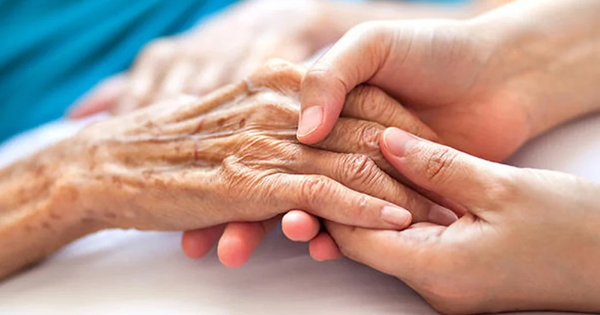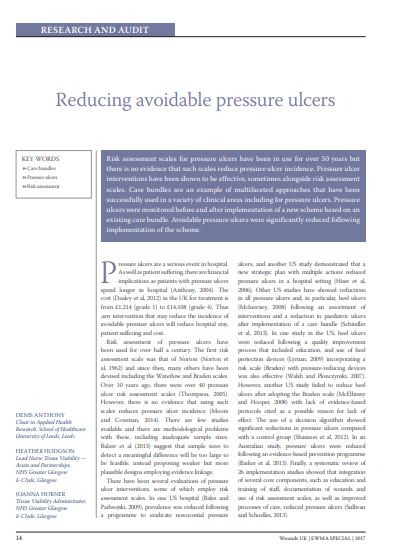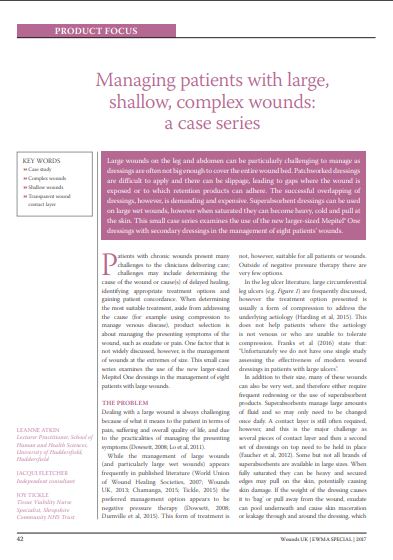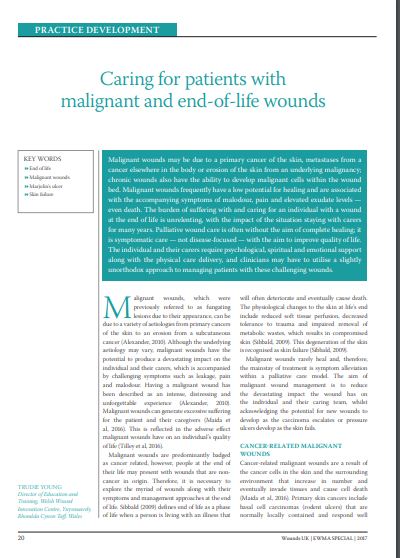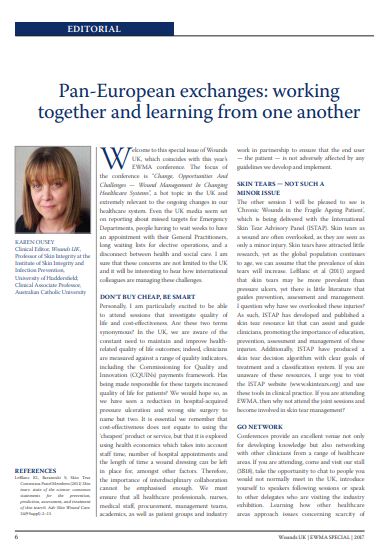It is estimated that nearly 4 million people in the UK live with cancer, making it one of the most significant societal challenges (MacMillan, 2022). More recently, Aggarwal et al (2024) stated that cancer affects one in two people in the UK, with the incidence set to increase due to increased life expectancy. In relation to the management of individuals with cancer, Wee et al (2021) suggested that palliative care (PC) and end-of-life care must be a priority since death and dying are inevitable. In 2014, the World Health Organisation (WHO) standardised PC access as a human right, making it an essential element of healthcare. PC refers to a team-based approach focused on preventing and relieving patient suffering and improving the quality of life (QoL) by managing physical, psychosocial and spiritual concerns (Meier et al, 2017). This review focuses on healthcare demands and patients’ expectations of palliative wound care (PWC) when they have malignant fungating wounds (MFW).
The term ‘palliative’ has also been applied to wounds; more specifically, the ‘palliation of wound’ is a recent approach that requires a different mindset than conventional wound care (Alvarez et al, 2016). Ferris et al (2007) described PWC as an extension of wound care and PC, similar to general PC. According to Chang and Lee (2022), PWC is a comprehensive approach to managing symptoms for vulnerable patients with a low QoL and focuses on delivering person- and family-centred interdisciplinary care.
The most common cause of MFW is advanced cancer, which infiltrates the skin and blood vessels (Grocott et al, 2013) and requires PWC approach (Sezgin et al, 2023). People with MFW experience distressing symptoms (such as pain, odour, exudate, bleeding, infection and pruritus), which can have detrimental effects on their physical, psychological and functional health during their last days of life (Grocott, 2000). The incidence of MFW is unknown as there is no registry monitoring this type of wound, unlike other chronic wounds (Pramod and Rice, 2023). Additionally, the prevalence is under-reported due to shame, embarrassment and fear (Alexander, 2009).
Healthcare demands of palliative wound care
The delivery or extent PC in the healthcare system depend on patient needs, expectations, wound complexity and the involvement of several disciplines (Sezgin et al, 2023). PWC aims to provide comfort and improve the patient’s QoL rather than solely focusing on completely healing the wound (Koumaki et al, 2023). To improve health status and access to healthcare, the WHO (2015) recommended integrated, patient-centred services to provide PWC to people with unhealable wounds. According to the National Health Services (NHS) 5-year plan, personalised care will be implemented nationwide in the UK by 2023/24 and double the personalised care provided to the patients with cancer by 2034 (NHS England, 2019). Despite policy provisions supporting personalised care in relation to needs for PC, Fang and Tanaka (2022) found significant discrepancies in the provision in the UK. Reed et al (2021) stated that healthcare services have not kept pace with demand because of population growth, rising morbidity and medical technology advances. Though Lo et al (2012) advocate that MFW care should be available at the onset of illness, lack of access to personalised care was consistent across settings, leaving patients to improvise strategies with little or no expert guidance (Tilley et al, 2016).
Person-centred care
According to NHS England, person-centred care (PCC) is “one of the cornerstones to creating world-class cancer services” (NHS England, 2018, p.5). The Institute of Medicine (2001) defines PCC as “providing care that is respectful of and responsive to individual patient preferences, needs, and values, and ensuring that patient values guide all clinical decisions.” PCC is a crucial goal in PC and end-of-life care services, striving to enhance care quality for patients and informal carers (Wee et al, 2021). Woo et al (2015) proposed that PCC begins by assessing the individual’s needs based on their social determinants of health and those of their circle of care. Salcido (2010) suggested using PCC as a philosophical anchor in wound care that emphasises the importance of people and their needs. Akoo and McMillan (2023) acknowledged that PCC is difficult to standardise since it is dynamic, diverse, and adjusted to the patient’s and family’s needs. Time constraints for conducting a comprehensive assessment can also impede PCC delivery (Diffin et al, 2018). Alexander (2010) reported that providing PCC for individuals with MFW presents a challenge since the patient’s problems extend beyond their physical well-being. Additionally, Carvajal et al (2019) identified a lack of continuity of care as a barrier to delivering PCC. It is believed that continuity of care can benefit patients by enabling them to feel understood, heard, and treated as capable individuals (Klarare et al, 2013). According to Hansson et al (2016) and Pirhonen et al (2020), patients receiving PCC acquired much lower healthcare costs than those receiving conventional healthcare. Furthermore, Nkhoma et al (2022) reported that PCC helps reduce hospital admissions, length of stay and unplanned visits, and the time and cost of care. Nevertheless, Meranius et al (2020) stated that the PCC may not be suitable for everyone because of their vulnerability and mental capabilities as there is a risk of increasing dependency and risk to the patient’s autonomy to be involved in his or her care. However, a systematic approach to PWC and MFW care can improve the QoL of the patient (Rupert and Farh, 2020).
Multidisciplinary team approach
A multidisciplinary team (MDT) approach involving nurses, social workers and PC physicians is crucial to the successful management of individuals requiring PWC (Koumaki et al, 2023). As more specialistsare involved in PWC, Neuman et al (2016) expressed concern that care would be more fragmented. According to Klarare et al (2013), defining roles and duties within a team can help to minimise fragmented care. Oncologists can benefit from wound care clinicians’ expertise in managing distressing wound symptoms. Qiu and Good (2021) recommended combining visits or developing professional relationships across specialities to avoid patients receiving conflicting information. Leach et al (2024) warned against misunderstandings, errors and gaps in care caused by inadequate documentation or information silos. The increasing number of patients requiring MDT increases workload, resource allocation and time, increasing healthcare demands (Walraven et al, 2023). Nevertheless, Meranius et al (2020) suggested that PCC can contribute to improved health and well-being, improved mutual interaction in relationships, improved cost-effectiveness and improved work environment. NHS England and NHS Improvement (2020) advise simplifying MDT activities and collaborating with the National Institute of Health and Care Excellence (NICE) to develop protocols which in turn could help address healthcare demands. A PWC plan must involve the collaboration of clinical specialists, such as tissue viability nurses and pain care specialists, to relieve the severe symptoms associated with MFW (Qiu and Good, 2021).
Symptom management
Lee and Chang (2022) indicated that nurses’ views could greatly influence integrated PWC as treatment aims to be palliation rather than healing. Symptom management for MFW should include preventing pain, controlling exudate and odours, reducing the burden of the wound to patients, and improving their QoL (Probst et al, 2013). Naylor (2002) advised that accurate assessment is crucial for effective symptom management, and outcomes depend on individual care goals, health status and wound stage. Koumaki et al (2023) emphasised the lack of clinical evidence for dressing choices, leading to guidelines based on majority opinion and case studies. Further, referrals to PWC are restricted by the cost or practicality of healing palliative wounds (Sezgin et al, 2023). Rupert and Fehl (2020) stated that time limits present a challenge in delivering quality care to patients with MFW. High healthcare demands may strain resources allocated to wound management, including staff, supplies and facilities, which can impact care delivery (Que and Good, 2021). To meet some of these healthcare demands, a proactive approach based on MDT collaboration, PCC and continuing education on wound management is required (Klarake et al, 2013)
Physical symptom management
Patients expect that distressing symptoms of MFW, such as pain, odour, bleeding, exudate, and infection, are managed to enhance their QoL (De Castro and Santos, 2015). Wound care is a critical feature of the management of MFW, and appropriate wound care can reduce symptoms (Rupert and Fehl, 2020). According to Young (2017), MFW symptoms present physical and emotional challenges for patients and can lead to withdrawal from society and affect the QoL. PWC requires MDT to preserve QoL, manage symptoms, and achieve treatment goals (Merz et al, 2011). Lo et al (2012) reported that patients expect wound-related information and pain relief from specialists early in their illness. Basile et al (2024) stated that a lack of continuity in symptom management frequently leaves patients feeling confused and lost. However, Reyonlds and Gethin (2015) found that patients are comfortable leading their day-to-day lives when the wound is managed appropriately. It is important to manage patient expectations to improve self-esteem, which restores a sense of purpose and improves physical health (Lo et al, 2012).
Psychosocial support
MFW management goes beyond treating physical symptoms since physical symptoms can impact a patient’s psychological and functional well-being (Probst et al. 2013). Given the importance of psychological support for individuals with MFW, healthcare providers are responsible for addressing these needs (Faria et al. 2021). Gibson and Green (2013) stated that the psychological effects of wounds may prevent patients from seeking help and ignoring the wounds. Schultz et al (2002) suggest performing psychosocial examinations to assess the patient’s mental status, ability to learn, depression, polypharmacy, values, lifestyle, sexuality and culture. Setting treatment goals and referrals for psychological support should be based on this assessment. Some NHS trusts do not offer psychological support, but organisations, such as Marie Curie, Maggie’s Centres, Cancer Research UK and McMillan Cancer Support, provide support in most places (NHS England, 2017). Due to their physical conditions and associated wound symptoms, not all patients with MFW can access these services (Sezgin et al, 2023). Health inequalities may prevent people from accessing this service in some socially deprived areas and are underused by ethnic minorities (House of Commons 2004). Healthcare demands, such as need for clear communication, can impact the patient, who may receive insufficient support for addressing psychological distress, which may also hinder the integration of psychosocial care with symptom management (NICE, 2019). A multifaceted approach is necessary to address the healthcare demands, prioritising staff support and training while allocating resources for providing psychological support for patients (NHS England, 2019).
Training
The Department of Health (Department of Health, 2016) pledged to have the right people with the right knowledge and skills to deliver high-quality personalised care. PC training and workforce provision were planned by the Department of Health (2016) with Health Education England, along with a national action plan for good practice. To meet the demand for education in PWC, Lee and Chang (2022) proposed that nurses should thoroughly understand patients’ diseases through education and wound care training. Mcdarby and Carpenter (2019) suggested that educating staff can improve their resilience and ability to handle complex care situations with PWC. Kaasalainen (2020) highlighted the limitations of staff education and proposed the need for an innovative and intelligent way to address the issue. Providing education to the staff can better equip them to meet the challenges posed by the management of MFW and deliver high-quality care, which is impossible if education is not offered (NHS England, 2019).
Patient expectation
Patients with MFW often have unique needs, and understanding their expectations can contribute to their overall QoL (Tandler and Stephen-Haynes, 2017). In the last two decades, healthcare providers have started to recognise the value of patient perspectives and decision-making regarding when, where, and how to care in a way that aligns with patients’ expectations (Kaasa et al, 2018).
Shared decision-making
Patients view active participation in decision-making as a fundamental entitlement and expectation (Thorne et al, 2013). The Kings Fund (2011) discussed that shared decision-making (SDM) should be prioritised in the NHS and introduced the document “No decision about me without me” to make SDM a reality (Coulter and Collins, 2011). Involving patients in care and treatment decisions helps to clarify acceptable medical options and helps them choose their preferred treatment (National Voices, 2014). However, when patients are offered multiple options for cancer and wound care treatment, the complexity of the information may hinder their active participation (Kaasa et al, 2018). According to Corbett and Ennis (2014), effective SDM in wound care requires providers to understand evidence-based care. Elwyn et al (2012) pointed out that low literacy, numeracy and certain cultural backgrounds can hinder independent decision-making in patients. Thorne et al (2013) claimed that informed and understood patients were better prepared for consultations, while a lack of these factors could lead to emotional distress during decision-making. It is encouraging to note that, in 2020, the Care Quality Commission reported that, generally, patients were given a significant or fair amount of input into care and treatment decisions. Furthermore, Svendsen et al (2024) reported that SDM promotes a democratic perspective for patients in the palliative phase, as it fosters patient autonomy and freedom of choice. If complete healing is impossible or undesirable, as in MFW care, SDM in care takes precedence, which involves the patient and healthcare professionals discussing together the patient’s ultimate priorities and developing a management plan that emphasizes the patient’s perspective rather than the healthcare professional’s perspective (Brown 2013).
Communication
Patients expect to receive honest information about their condition and possible treatment promptly and sensitively at all stages (NICE, 2019). To meet the reasonable expectations of the patient and family, Leach et al (2024) recommended providing transparent information about the prognosis and treatment challenges of MFW. Dong et al (2016) stated that the staff should be confident and knowledgeable when discussing patients’ conditions while remaining positive and providing facts. Kmetec et al (2022) argued that open and sincere communication enables individuals to reflect on their circumstances and develop plans. Mack and Smith (2012) advised that honest communication, even when news is negative, can enhance the clinician–patient relationship by fostering hope and maintaining well-being. Conversely, delaying discussions regarding prognosis can result in mistrust, anxiety, lower QoL and family suffering (Bernacki and Block, 2014). Effective communication ensures that patients’ expectations are managed and, therefore, healthcare demands are met, resulting in increased patient satisfaction, increased compliance, and improved health outcomes (Ghosh et al, 2020).
The challenge lies in the patient’s health literacy in receiving the information, as 7.1 million adults in the UK read and write at or below the level of a 9-year-old, and 43% of adults need help understanding written information (NHS England, 2024). Furthermore, 61% of England’s working-age population needs help comprehending health information containing text and data (Public Health England, 2015). Language barriers can also present communication difficulties (Carvajal et al, 2019). To address some concerns raised, Kaasa et al, (2018) advocated giving information in non-technical language based on the patient’s and their family’s requirements. Additionally, McGlade et al (2017) recommended delivering culturally sensitive educational resources in large font, at a suitable literacy level, and in bite-sized chunks. As related to PWC, the National Academies of Sciences, Engineering, and Medicine (2016) describe health literacy as an integrated process to ensure that patients understand, process, and implement the information they receive, both at home and in the community.
Quality of life
Basile et al (2024) suggested providing comprehensive support for patients diagnosed with MFW to alleviate physical and psychological symptoms and enhance their QoL. The quality of care can be determined by the patient’s preferences, expectations, and experiences (Sandsdalen et al, 2015). QoL is defined by WHO (2004) as the subjective perception of reality, the cultural and value system, and the goals of individuals. Patients’ view of QoL differs from that of physicians; clinicians base their assessment on the outcome of their treatment, whereas patients evaluate the outcome based on their personal sense of well-being (Chaturvedi and Muliyala, 2016). Furthermore, patients value well-being more than wound healing with MFW (Isoherranen et al, 2019). Cai et al (2021) stated that patients should receive treatment that eliminates illness or symptoms and promotes their overall health and QoL. Patient-reported outcomes on both preferences and experience must be measured to understand the QoL beyond their clinical benefit (Sandsdalen et al, 2015).
Respect and dignity
Patient expect to be treated with respect and dignity and to have their ‘suffering’ validated even when their wounds are not healable (Melhem and Daneault, 2017). Living with palliative wounds can lead to feelings of embarrassment, shame, or loss of self-worth. Offering emotional support, acknowledging their feelings, and creating a non-judgmental environment can all contribute to their dignity (Kmetec et al, 2022). According to Gethin et al (2020), in PWC, taking the time to understand and incorporate the patient’s treatment preferences indicates respect and can give the patient a sense of peace and dignity. It is important to take the time to listen to people with palliative wounds, reply to their queries, and go at their pace to respect their dignity while they are cared for, whereas hurrying through care processes can make patients feel dehumanised or undervalued (Sandsdalen et al, 2015).
Conclusion
As the incidence of cancer is predicted to increase, the number of patients with MFW is likely to increase (Vardhan et al, 2019), which will also increase healthcare demands (Kaasalainen et al, 2020). There is a growing healthcare demand as there is an increase in patients requiring MDT and PCC, which require resource allocation, time and qualified practitioners (Cancer Research UK, 2020). Patients often appreciate continuity of care and access to support services to enhance their QoL(Klarare et al, 2013). Streamlining the activities of MDT along with the use of protocols, particularly for MFW, can bring continuity of care, reduce variation in access to treatment, and improve patient outcomes (NHS England and NHS Improvement, 2020). Providing the right care to the right people is crucial, as it helps meet both the healthcare demands and patient expectations (Department of Heath, 2016). Providing patients with honest and open information regarding their wound care is essential for them to understand the complexity of wound care (Aggarwal et al, 2024). The SDM ensures that patients are involved in decision-making about their care, and no decision is made without their consent (Corbett and Ennis, 2014). Patients receiving PWC expect healthcare practitioners to address all components of physical, social, psychological, and economic care to improve their QoL, reminding them that the patient comes first (Gethin et al, 2020).

